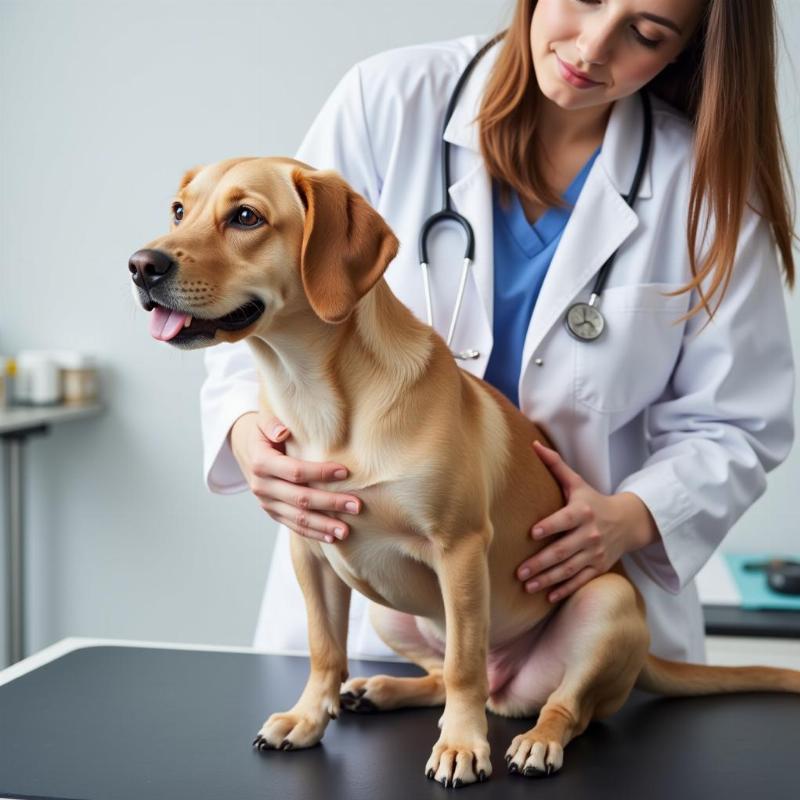Is your furry friend sitting in an unusual way? Perhaps they’re perched precariously, leaning to one side, or refusing to put weight on a paw. “My dog is sitting weird” is a common search query for worried pet owners, and rightly so. A change in your dog’s sitting posture can be a subtle sign of discomfort, pain, or even an underlying medical condition. Understanding what different sitting positions might indicate can help you determine if a trip to the vet is necessary.
Why Is My Dog Sitting Weirdly? Possible Explanations
Dogs communicate primarily through body language, and their sitting posture is no exception. A weird sitting position can be a clue to a variety of issues. From simple muscle soreness to more serious joint problems, let’s explore some common reasons for unusual sitting habits in dogs.
Discomfort or Pain
Perhaps the most obvious reason for a dog to sit strangely is discomfort or pain. Think about it – if you had a sore back, you wouldn’t sit upright in a stiff chair, would you? The same applies to our canine companions. Arthritis, hip dysplasia, and even a simple muscle strain can cause your dog to shift their weight, sit at an angle, or avoid putting pressure on a particular limb.
Underlying Medical Conditions
Beyond pain, several medical conditions can manifest in unusual sitting postures. Neurological issues, spinal problems, and even digestive upset can cause a dog to sit differently. For example, a dog with a slipped disc might sit with a hunched back and a tucked tail.
Behavioral Reasons
Sometimes, a weird sitting position isn’t a sign of anything serious. It might simply be a quirky habit your dog has developed. Or, it could be a sign of anxiety or stress. Observe your dog’s overall behavior. Are there any other changes, like loss of appetite or increased panting?
What to Do If Your Dog is Sitting Weird
Noticing your dog sitting strangely can be concerning, but don’t panic. Here’s a step-by-step guide to help you navigate the situation:
- Observe: Carefully watch your dog’s posture. Note any specific abnormalities, such as favoring a limb, hunching, or trembling.
- Check for Injuries: Gently examine your dog for any visible injuries, like cuts, swelling, or tenderness.
- Consider Recent Activities: Think back to your dog’s recent activities. Have they been exercising strenuously? Could they have injured themselves while playing?
- Monitor for Other Symptoms: Look for other signs of illness or distress, like changes in appetite, lethargy, vomiting, or diarrhea.
- Consult Your Veterinarian: If the unusual sitting persists, worsens, or is accompanied by other symptoms, it’s crucial to consult your veterinarian.
When to Seek Immediate Veterinary Attention
While not every instance of weird sitting requires a rush to the vet, some situations warrant immediate attention. These include:
- Sudden onset of the unusual posture
- Yelping or crying in pain
- Inability to stand or walk
- Obvious signs of distress, such as heavy panting or pacing
 Dog Sitting Weird at Vet Visit
Dog Sitting Weird at Vet Visit
Conclusion: Prioritizing Your Dog’s Well-being
If your dog is sitting weird, it’s essential to pay attention. While some unusual postures might be harmless quirks, others can indicate underlying health issues. By carefully observing your dog’s behavior and consulting with your veterinarian when necessary, you can ensure your furry friend receives the appropriate care and maintains a happy, healthy life.
FAQ: Addressing Common Concerns
-
Q: My dog is sitting with its legs splayed out to the sides (frog-leg posture). Is this normal?
- A: While not necessarily an emergency, this posture can indicate hip dysplasia or other joint issues. Consult your veterinarian.
-
Q: My older dog is sitting more hunched over than usual. Should I be worried?
- A: This could be a sign of arthritis. Your veterinarian can assess your dog’s condition and recommend appropriate pain management.
-
Q: My dog is sitting and leaning to one side. What could this mean?
- A: This could indicate pain on the opposite side of the body. A veterinary examination is recommended.
-
Q: My dog is sitting with its tail tucked between its legs. Is this always a sign of fear?
- A: While a tucked tail can indicate fear, it can also be a sign of pain or discomfort. Consider your dog’s overall body language and consult your veterinarian if you’re concerned.
-
Q: My dog started sitting weirdly after a long walk. Should I take them to the vet?
- A: If your dog seems otherwise normal and the unusual posture resolves within a day or two, it might be simple muscle soreness. However, if it persists or worsens, consult your veterinarian.
Beautdogs.us: Your Trusted Partner in Dog Care
Beautdogs.us is your premier online resource for all things dog-related in the US. We offer expert advice on dog breeds, care, and products, catering to both new and experienced dog owners. Our team of dedicated pet professionals provides reliable, comprehensive, and engaging information to help you navigate the joys and challenges of dog ownership. For inquiries, contact us at [email protected] or call us at +1 501-555-7529. Beautdogs.us – your trusted partner in providing the best possible care for your beloved canine companion.